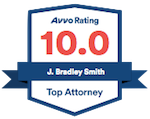WE FIGHT TO WIN!
North Carolina Land Use: What is a Prescriptive Easement?
A prescriptive easement is a legal doctrine that describes a situation in which one person uses the land of another without permission or without having legal title or some other ownership of the land in question. A common example is a person using a private road on another person's property. In North Carolina, if that unauthorized use lasts for at least 20 years, the person using another person's land can claim a prescriptive easement.
To be eligible to be declared in possession of a prescriptive easement, a person must establish four legal elements. These are:
- That the use is adverse, hostile or under claim of right
- That the use has been open and notorious such that the true owner had notice of the claim
- That the use has been continuous and uninterrupted for a period of at least 20 years
- That there is substantial identity of the easement claimed throughout the 20-year period
See Perry v. Williams, 353 SE 2d 226 (NC Court of Appeals 1987).
The Perry case provides a good example of how a prescriptive easement can be established. Perry involved land in rural North Carolina. For more than 40 years, the plaintiff -- Grace Perry -- claimed that she and her predecessors had used a private road -- a farm track -- over K.C. Williams' land for ingress and egress to Perry's farm fields. Every season, the fields were cultivated and crops were harvested. Equipment and crops grown were transported back and forth on the road. In 1985, Williams blocked off the road and litigation ensued. After a jury trial, the court ultimately held that Perry had established the four necessary legal elements to be entitled to a prescriptive easement.
With regard to the first element, the law does not use "hostile" in the ordinary manner. No argument or fight or hostile activity is required to prove "adverse or hostile use." Rather, what must be proven is that use was made "under claim of right" AND that the use was not permissive.
In reviewing North Carolina case decisions, the most common method of showing "adverse or hostile" use is to prove that the non-owner engaged in activities like repair and upkeep. In general, people do not maintain and repair other people's property. Doing so is a sign that the person is using another person's property "under a claim of right" and without permission. If permission were granted, then the true owner would be under some obligation to engage in repair and maintenance.
This is how Perry was able to prove "adverse or hostile" use. Occasionally, over the 40 years of use, Perry and her workers fixed holes in the road, filled in low spots and trimmed trees and brush along the road to allow better access and navigability. The court held this to be sufficient evidence to rebut the presumption that use was permissive.
With respect to the second element -- open and notorious use -- the person claiming a prescriptive easement must show that the use was of such a character that "... the true owner may have notice of the claim." Perry was able to prove this not only by showing that she and her farm workers repaired the road, but by showing that the roadway was used to transport various large farming equipment—like tractors, wagons and harvesters -- to the farm fields. This movement of equipment occurred at all hours of the day during the farming season. Perry did not hide or otherwise try to "sneak in." This evidence was sufficient to show open and notorious use.
With respect to the third element, the evidence was clear that, for at least 20 years, there had been continuous and uninterrupted use of the private road. Use of the road began in 1942 and was started by Perry's brother-in-law and was later continued by Perry herself.
As for the fourth element, there was no dispute that the road had been in the same location since 1942 and had not deviated substantially since that time.
Although prescriptive easements are most commonly acquired for roads and driveways, prescriptive easements can be acquired for walking paths, parking spaces, water access and docking and much more. In urban areas, prescriptive easements might even be obtained for sunlight and air circulation.
Contact Experienced Mecklenburg County Land Use Attorneys TodayFor more information, and to schedule a confidential consultation with experienced and dedicated zoning and land use attorneys in Charlotte, contact Arnold & Smith, PLLC. Use our “Contact” page or give us a call at 704-370-2828. We handle land use, zoning and condemnation legal matters in Mecklenburg County and elsewhere in North Carolina. We have offices in Charlotte, Lake Norman, and Union County.
 Charlotte Land Use Lawyers Arnold & Smith Home
Charlotte Land Use Lawyers Arnold & Smith Home

























